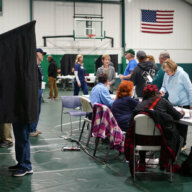 Credit: Metro file photo
Credit: Metro file photo
Every three weeks, SEPTA general manager Joe Casey will address public transit questions submitted by Metro Philadelphia readers. Anything from frequency of trains to funding to cleanliness and more is fair game. Ask Casey whatever you like by emailing City Editor Christina Paciolla at [email protected], who will then forward along your queries.
Ask SEPTA is part of our new column series, which also features political columnist Matthew Turner and lifestyle columnist Kathryn Quigley. The columns run each Monday in our Metro Philadelphia print edition and online.
Question: I live near the Forest Hills station, where the trains honk at all hours of the day because it crosses a street. I understand the need for safety, but this is a residential area and the honking has been affecting our baby’s sleep. Is there anyway a “non-honking” decree (or at least a one honk rule) can be put into effect between 10pm-6am when people are sleeping? Alan Fox
Joe Casey: The movements and safe operation of SEPTA commuter railroad trains are governed by rules that fall under the auspices of the Northeast Operating Rules Advisory Committee or NORAC. At Forest Hills Station, NORAC Rule 19(b) states that two long horn bursts, followed by one short burst followed by one long burst must be sounded “when approaching a public highway at-grade rail crossing.” These and other regulations also dictate that SEPTA trains sound their horns at work areas, occupied sidings and other locations where it is necessary to announce the presence of an oncoming train. These regulations are in place for the safety of pedestrians or vehicular traffic. While I empathize with the annoyance that the horn soundings create, SEPTA is required to comply with NORAC rules and safety is our first priority in the operation of our service.
Question: The Silverliner cars on the West Tenton are often standing room only by the time they reach Center City but the front two seats of the first car are always blocked off with yellow tape. Why? JB Woodman
Joe Casey: The first two seats of the first car in all in-service Silverliner V sets are cordoned off as a safety measure for operating engineers and for our riders. It has been determined that in the event of a collision or accident involving the front end of the train, the operating engineer may have to quickly evacuate the operating cab. In order to enable that evacuation to take place quickly and in an safe manner for passengers seated near the cab, the first two seats must remain unoccupied or passengers in the front seats could be trapped and present a potentially fatal situation. Keep in mind that only the first two seats in the first car are cordoned off. Passengers may occupy all other front row seats throughout the rest of the multiple car trains.
Question: As a Septa rail rider, I would like to know if the equipment problems that plague the Trenton Line weekly are going to be fixed. It seems that lately at least once a week there is some kind of equipment problem which makes this train late. As a monthly train pass rider, I would have to say that the cost of riding the SEPTA rail is expensive and the condition of the rail cars and late schedules are really sad. The looks of the 30th Street rails coming into the city are an eyesore but I’ll take the eyesore if it’s safe. But it would be nice to get to work on time every day and be able to rely on SEPTA schedules. Eileen Hulme
Joe Casey: While our overall on-time performance on some of SEPTA’s regional rail lines, such as the Trenton Line, does decline somewhat during the fall and winter seasons, there are several factors contributing to this decline. First, there is the annual phenomenon known as “slippery rail” when rail heads on the system become extremely slippery due to the oil produced by crushed falling leaves. To maintain traction, travel speeds are significantly reduced. This phenomenon occurs each year and affects most railroads on the east coast. To minimize slippery rail, during the late evenings, we run special trains equipped with high pressure washers, sand and special gel designed to improve traction. Another factor related to your observation is the unusually early cold and snowy conditions. At the beginning of every winter, the reliability of our equipment gets tested with the first cold snap and snow event. Rest assured we are addressing these issues and working hard to avoid repeat problems.
Please also be aware that SEPTA recently received new capital funding and we plan to replace old equipment and upgrade aging infrastructure in the near future. However, the 30th Street rail facilities are owned and maintained by Amtrak.
Question: I would like and answer about the parking meter machines at the Fern Rock station. At the large parking lot, it cost $2 per day to park. I have been using this lot for a little over a year now. Prior to the SEPTA rate increase that went into effect in July, I could use a token along with an additional quarter to pay for the parking. When the rates went up, the cost per token became $1.80. I understand there is no longer a discount involved however the machines were never adjusted to reflect the value of the token has changed from $1.75 to $1.80. As a result, I get cheated out of five cents every day that I park my car.
When I addressed this with the people at the station, they said ask Parking. When I asked Parking, they said there is no discount. I’m not asking for discount. I’ve been told there was a parking pass that I could get for the lot however no one at the station could seem to tell me how I could purchase one and I don’t see where I could swipe it if I had one.
It’s extremely inconvenient to get two dollars worth of change daily to put in the machine and if the machine is set to accept tokens, it should be correctly calibrated to charge the correct amount. This is the only city Septa lot that charges $2 per day. The least you could do is make the amount charged correct.Rhonda Cooper
Joe Casey: The Fern Rock parking rate of a token plus a quarter was established in response to numerous customer complaints that having to gather two dollars’ worth of change each morning to pay for parking was inconvenient. In response, SEPTA changed the software on the meters to accept only two coins, a token plus a quarter. This was done strictly as a convenience to customers. It was not done to create a discount. When the price for a token went up from $1.55 to $1.80, SEPTA continued to allow for a payment of a token plus a quarter, which satisfied the parking fee requirement, but more importantly, still offered the convenience of only needing two coins for payment. With the implementation of SEPTA’s new fare system, payment of parking fees will be simplified and remedy the requirement of exact change.
Send your questions about SEPTA services and other issues about the transit agency to [email protected]. They will be forwarded to Joe Casey who will answer them in a special monthly column here.





























